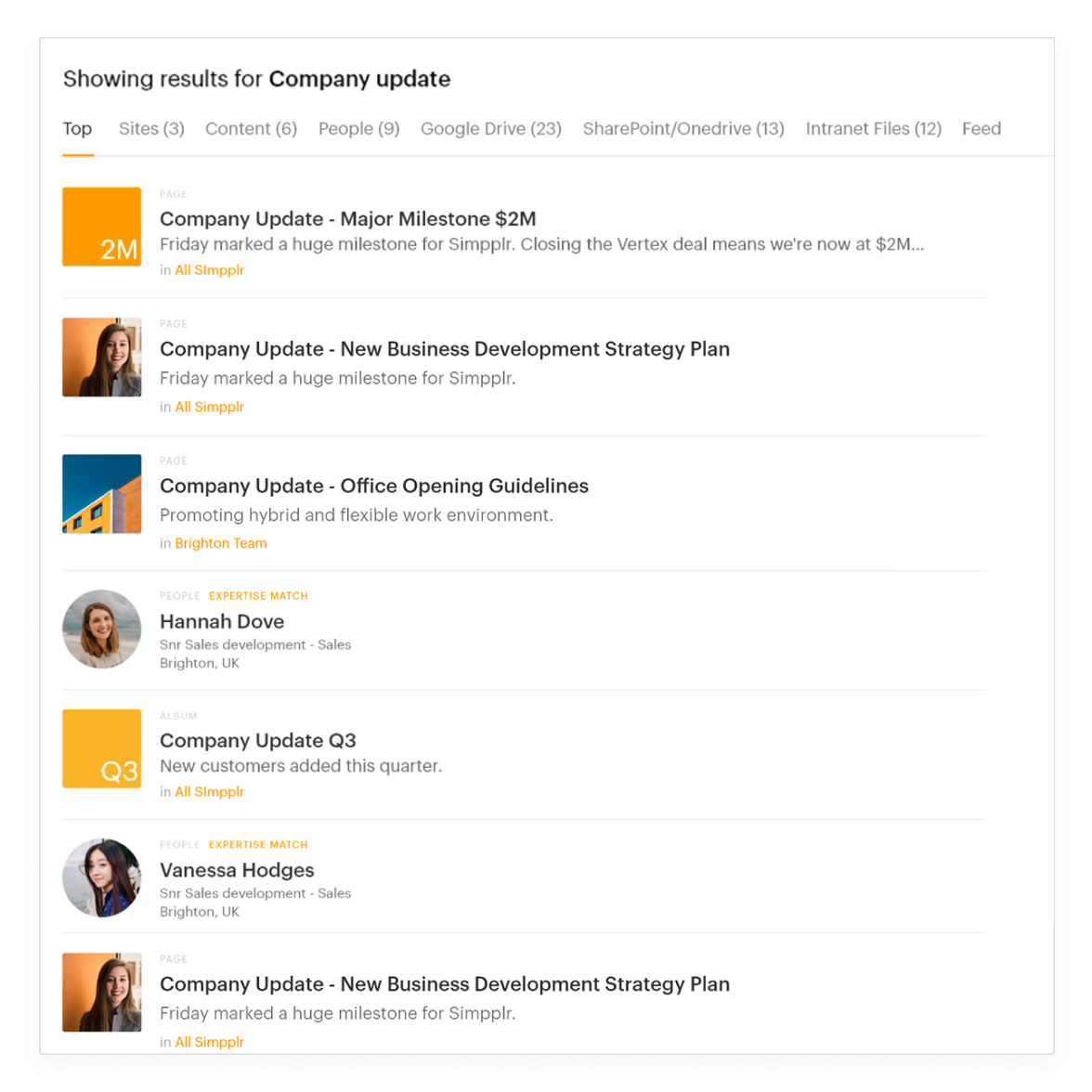What is collaborative leadership?
Collaborative leadership is a managerial approach where leaders collaborate across different levels and departments to drive their organization forward. It prioritizes utilizing diverse perspectives and collective intelligence to drive creativity and effective problem-solving.
- 1 What collaborative leadership looks like
- 2 How do you become a collaborative leader?
- 3 Benefits of collaborative leadership
- 4 Five key strategies for implementing collaborative leadership
- 5 Leveraging technology for collaborative leadership
- 6 AI and data-based decision making
- 7 How can Simpplr help you be a collaborative leader?

The approach of collaborative leadership is driven by the idea that when everyone feels like a leader, they’re more engaged. Collaborative leadership achieves this by ensuring that everyone feels valued and empowered. That’s why companies using this approach have happier and more connected employees.
In modern workplaces, the paradigm of leadership is evolving. An O.C. Tanner report highlighted that 81% of contemporary leaders operate within organizations where every employee perceives themselves as a leader.
Thus, traditional top-down leadership models are increasingly giving way to more inclusive and participatory approaches. Unlike the past hierarchical structure, where decisions were made solely by top executives and passed down without much transparency, collaborative leadership emphasizes teamwork and collective decision-making.
What collaborative leadership looks like

A collaborative leader is distinguished not by a title or a formal classification, but by their understanding that success is dependent on group effort and shared accountability. While collaborative leaders may not wear a badge to identify themselves, they are found in various settings. What distinguishes them is their ability to gain the trust and respect of every organization and individual they deal with.
Collaborative leaders typically stand out for their genuine commitment to the success of the collaboration without seeking personal gain from their leadership role. They prioritize building solid relationships and creating an inclusive environment where everyone feels valued and motivated to contribute. They embrace teamwork as a core value, empowering individuals within the organization.
How do you become a collaborative leader?
To become a collaborative leader, you must embrace critical principles that promote a culture of teamwork and cooperation among your leadership team members. Collaborative leaders typically share certain leadership principles regardless of who they are or where they come from.
Now, let’s dive into how you can make these principles a part of your leadership journey:
1. Embrace inclusivity: Value inclusivity and actively engage all leadership team members in decision-making. Encourage varied perspectives and create a space where everyone feels heard and appreciated.
2. Practice transparency: Communicate clearly about objectives, challenges, and decision-making processes. This transparency builds trust and alignment among team members, promoting open communication and minimizing misunderstandings.
3. Empower individuals: Delegate authority and encourage team members to take ownership of their work. Instill confidence by offering autonomy and support, allowing them to reach their full potential.
4. Encourage adaptability: Be open to change and encourage your team to adapt quickly to new problems and possibilities. Create a culture of adaptability and innovation to thrive in a constantly evolving business environment.
5. Build relationships: Invest time developing good relationships with your teammates. Create a culture of trust, respect, and support to lay the foundation for effective collaboration and teamwork.
6. Promote conflict resolution: Encourage discussions to overcome differences and reach mutually beneficial solutions. Proactively address conflicts to maintain a positive team environment and foster open communication and collaboration.
Benefits of collaborative leadership

Traditional top-down leadership models are proving inadequate for navigating the complexities of modern organizations. Collaborative leadership emerges as a compelling alternative, offering a host of benefits that not only empower teams but also drive organizational success.
Let’s explore how adopting a collaborative leadership style can transform your workplace dynamics:
- Enhanced decision-making: Rather than depending simply on the insights of a few decision-makers, collaborative leadership promotes the participation of all team members in decision-making processes. This strategy draws on the team’s different experiences and perspectives, resulting in better-balanced and informed judgments.
- Improved employee morale: A collaborative leadership style promotes an inclusive atmosphere in which the opinions of all team members are acknowledged and respected. By allowing individuals to offer their ideas and thoughts, leaders enhance morale and create a sense of ownership among team members, resulting in higher job satisfaction and engagement.
- Increased innovation: Collaboration fuels creativity and innovation by bringing together individuals with different backgrounds, skills, and experiences. In a collaborative setting, team members are encouraged to exchange their ideas freely, producing new views and unique solutions to complicated challenges.
Five key strategies for implementing collaborative leadership
Implementing collaborative leadership within your organization requires a thoughtful approach and a commitment to cultivating a culture of cooperation and teamwork. Here are some key strategies to help you successfully integrate collaborative leadership into your organization:
1. Promote cross-functional collaboration
Eliminate silos and encourage collaboration across departments and teams. Provide opportunities for employees from different areas of the organization to work together on projects and initiatives, fostering a shared understanding and appreciation of each other’s perspectives.
2. Provide training and resources
Equip leaders and team members with the skills and tools to collaborate effectively. Provide training programs in active listening, conflict resolution, and effective communication to enable individuals to contribute their full potential to collaborative initiatives.
3. Lead by example
Display collaborative leadership behaviors in your interactions with team members. Be personable, open-minded, and eager to listen to other people’s views and suggestions. By modeling collaborative behavior, you set the tone for a culture of teamwork and cooperation within the organization.
4. Establish clear goals and expectations
Establish the objectives, roles, and expectations for collaborative projects and activities. Ensure that team members understand their roles and how they contribute to the organization’s goals. Regularly discuss progress and provide feedback to keep everyone on track and encouraged.
5. Encourage innovation and experimentation
Create an environment that promotes experimentation and risk-taking. Foster a culture in which team members feel empowered to test new ideas, question the status quo, and learn from successes and failures. Celebrate innovative thinking and reward efforts that drive positive change.

Leveraging technology for collaborative leadership
The rise of digital collaboration tools has completely changed how organizations connect and work together. These technologies aren’t just handy; they’re essential for breaking down barriers among employees, whether it’s physical distance or just how we interact.
Imagine being able to chat instantly with your team, no matter where they are. Digital collaboration tools make that possible. According to a McKinsey survey, 97% of employees agree that good communication and collaboration directly affect how well tasks and projects turn out. With tools like instant messaging, video chats, and virtual whiteboards, you’re all in the same room, even if you’re miles apart.
But it’s not just about communicating—these tools also make it easy to share information. They open up exciting new ways to work together on projects. With shared calendars, task lists, and project management boards, everyone knows what to do and who’s responsible for what. This encourages accountability and teamwork because everyone sees how their efforts contribute to the overall picture.
AI and data-based decision making
Artificial intelligence and machine learning are altering collaborative leaders’ decision-making processes. With the ability to quickly evaluate large amounts of data, AI-powered tools provide essential insights that help people make informed decisions. Furthermore, AI and machine learning can optimize workflows by automating tasks, increasing efficiency and productivity while freeing up resources for innovation and strategic projects.
A few examples of Simpplr’s AI in action:
- Simpplr’s AI-powered sentiment analysis lets you capture the pulse of your employees, while maintaining their anonymity, to make data-backed decisions that boost employee morale and retain talent
- Simpplr’s generative AI writing assistant makes it easy to generate solid first drafts for blogs, newsletters, and emails in seconds
- Our AI-powered search understands natural language and searches across multiple business systems to provide employees with the information they need
- Instead of having to asking HR, our conversational AI Assistant connects to your other systems to provide relevant, accurate answers and automate complex workflows for each and every employee
- AI is here to stay, and AI-powered tools can enable collaborative leaders to navigate complexity, create innovation, and achieve long-term success in a dynamic environment.
The role of modern intranets in collaboration
Every day presents new problems, tasks, and chances for collaboration. However, in the middle of the hustle and bustle, efficient communication and resource management may quickly become overwhelming jobs. This is where the modern intranet changes how your team collaborates.
Let’s get to the heart of it:
Communication: A modern intranet transforms internal team communication channels. Team members can easily communicate ideas and opinions in group sites and discussion forums. This encourages an open communication culture by breaking down divisions and ensuring everyone is on the same page.

Resource management: A modern intranet like Simpplr is excellent at centralizing resources and papers and streamlining collaborative efforts through the use of 200+ out-of-the-box integrations and APIs. The days of searching through cluttered directories, multiple apps and outdated servers are over. Team members can easily access essential information and files via one single source-of-truth, improving project efficiency and accuracy.

Flexibility: A modern intranet can provide remarkable versatility, allowing for seamless cooperation across regional borders and promoting collaboration. Whether your team works from the office, home, or on the road, they can access the intranet using any device that has an internet connection.

How can Simpplr help you be a collaborative leader?
Effective collaboration lies at the heart of any successful team. Simpplr’s AI-powered employee experience platform can facilitate transparent and collaborative leadership, by serving as a digital hub for your employees to go to for all information relating to your organization, keeping teams on the same page. By openly sharing information, communicating decisions, celebrating wins, and providing insights into business decisions, you can create an environment where employees feel valued and informed.
Schedule a live demo today to experience how Simpplr can streamline communication and boost collaboration in your digital workplace.

Watch a 5-minute demo
See how the Simpplr employee experience platform connects, engages and empowers your workforce.
- #1 Leader in the Gartner Magic Quadrant™
- 90%+ Employee adoption rate
Related Resources:
- Explore The Advantages Of Collaboration In Teams
- Discover The Inclusive Leadership Framework For Effective Management
- Understanding The Concept Of Leadership In Organizations
- Examine Strategies For Enhancing Diversity In Hiring Practices
- Discover Creative Approaches To Enhance Collaboration In The Workplace







